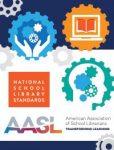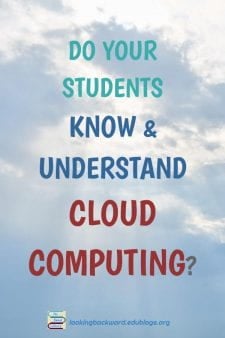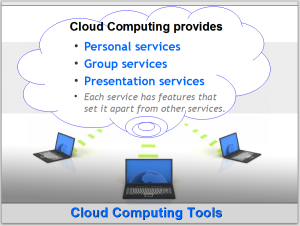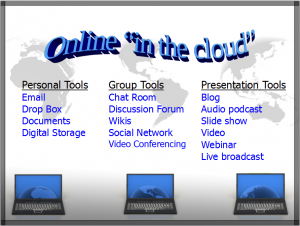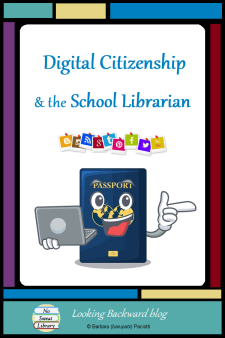 Digital Citizenship encompasses a student’s knowledge of and consent to using technology in a responsible manner. In our increasingly digital online global community, it’s not just important for School Librarians to teach students about digital citizenship, it is required by law!
Digital Citizenship encompasses a student’s knowledge of and consent to using technology in a responsible manner. In our increasingly digital online global community, it’s not just important for School Librarians to teach students about digital citizenship, it is required by law!
In a prior post (Student Privacy & the School Library), I covered the 3 Federal laws—FERPA, COPPA, and CIPA—that govern students using the Internet.
Download my PDF of Internet Laws In a Nutshell
In this post I address Internet Safety as it is covered by CIPA. For schools to receive an e-rate discount, they must show documentation that their students are being given instruction about Internet Safety.
CHILDREN’S INTERNET PROTECTION ACT
The relevant passages are found in the CIPA update of 2011 which incorporates language from the Broadband Data Services Act of 2008, Title II–Protecting Children [in the 21st Century Act], Subtitle A–Promoting a Safe Internet for Children:
SEC. 211. INTERNET SAFETY.
… use of the Internet in a manner that promotes safe online activity for children, protects children from cybercrimes, including crimes by online predators, and helps parents shield their children from material that is inappropriate for minors.SEC. 212. PUBLIC AWARENESS CAMPAIGN.
The Federal Trade Commission shall carry out a nationwide program to increase public awareness and provide education regarding … safe use of the Internet by children. … that includes–
(1) identifying, promoting, and encouraging best practices for Internet safety;
(2) establishing and carrying out a national outreach and education campaign regarding Internet safety utilizing various media and Internet-based resources;
… (4) facilitating access to Internet safety education…by…schools, … .SEC. 215. PROMOTING ONLINE SAFETY IN SCHOOLS.
… part of its Internet safety policy is educating minors about appropriate online behavior, including interacting with other individuals on social networking websites and in chat rooms and cyberbullying awareness and response.
(Broadband Data Services Act from the Government Printing Office Website.)
FREE INTERNET SAFETY MATERIALS!
Since schools are required to teach Internet Safety, the U.S. government provides FREE materials with which to do so, and since government information falls under public domain, we can use any of it—as is or modified—for our lessons.
- The FTC’s Internet safety Website—onguardonline.gov—provides videos and materials for presentations, as well as free handouts such as booklets, brochures, and worksheets, which can be ordered from their Website.
- The Department of Homeland Security’s Stop-Think-Connect campaign also provides free materials on their Website—dhs.gov/stopthinkconnect.
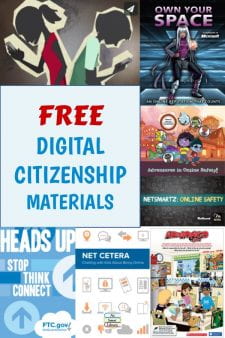 I reiterate, these materials are free, so I encourage you to order them. I use different handouts for each grade level, and at the start of each school year I order enough copies for all students in my school. Other free materials, such as online videos and games for each age group, are also provided by government-sponsored organizations:
I reiterate, these materials are free, so I encourage you to order them. I use different handouts for each grade level, and at the start of each school year I order enough copies for all students in my school. Other free materials, such as online videos and games for each age group, are also provided by government-sponsored organizations:
- National Cyber Security Alliance at staysafeonline.org has valuable pointers on how to teach online safety to various age groups.
- National Center for Missing & Exploited Children at netsmartz.org
- Common Sense Media at commonsensemedia.org.
3 ELEMENTS OF DIGITAL CITIZENSHIP
The online world is about social interaction without face-to-face contact, and as a middle School Librarian I need to align my lessons with the unique mental and emotional characteristics of each grade:
- 6th graders are eager to explore the adult world, but are vulnerable and still want advice from adults; their lessons need simple and direct examples of what to do and what not to do, presented in an interactive way.
- 7th graders are flooded by hormonal changes, and peers are way more important than adults, so they need socializing norms and skills; their lessons need to be fast-paced and varied, especially short, interactive games and videos of students, animated or real, talking about issues pertinent to them.
- 8th graders are on the verge of adulthood but still naive about the ways of the world, so they need awareness and guidance to exercise good judgment; their lessons need to incorporate experiences of other teens by using real-life videos coupled with discussion and reflection.
I spent many hours perusing government and non-profit Websites, noting their topic choices and organization in order to create the best possible lessons for my middle school students. To keep things simple, I organize my lessons using these 3 Elements of Digital Citizenship:
- Personal Safety – protection from online predators and cyberbullying;
- Privacy and Security – protecting school passwords and personal school files, and personal information from online computer intrusions, identity theft, phishing, and Internet scams;
- Digital Ethics – proper online behavior, such as legal use of software and other digital material, online Netiquette, and our digital footprint—how the “mark” we leave online is our e-reputation and can impact our future.
MY DIGITAL CITIZENSHIP LESSONS
As I do for all my Library Lessons, I teach only what students need and avoid anything that isn’t purposeful, yet throughout the school year I infuse legal, ethical, and safety issues into any Library Lesson that involves technology. For example, my first WebQuest with 6th graders is often their first login on our school’s computers, so I begin with guidance on creating a strong unique password. Shortly thereafter I incorporate personal safety and communication ethics when I introduce our district’s filtered student email system in my Library Lesson on Cloud Computing. During the rest of the school year I use videos and handouts from the FTC, NCSA, Common Sense Media, and other non-profits to make my lessons more meaningful.
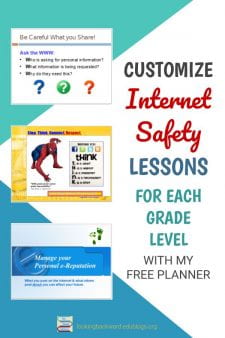 My school district advises School Librarians to do a yearly presentation on Internet safety to comply with CIPA’s e-rate requirement, and they provide us with a generic slide presentation. I customize the slideshow, targeting content to the theme I’ve chosen for each grade level, and I incorporate videos, games, and handout activities from government and non-profit sites. For a complete bibliography of all the resources I’ve compiled for my middle school digital citizenship & Internet safety lessons, download a FREE PDF file of my Digital Citizenship Lesson Planner.
My school district advises School Librarians to do a yearly presentation on Internet safety to comply with CIPA’s e-rate requirement, and they provide us with a generic slide presentation. I customize the slideshow, targeting content to the theme I’ve chosen for each grade level, and I incorporate videos, games, and handout activities from government and non-profit sites. For a complete bibliography of all the resources I’ve compiled for my middle school digital citizenship & Internet safety lessons, download a FREE PDF file of my Digital Citizenship Lesson Planner.
To really connect with students, here’s a phenomenal idea to use when teaching digital citizenship:
Craig Badura, Technology Integration Specialist for Aurora Public Schools NE, has an ingenious set of props to help K-8 students relate and remember digital citizenship lessons. He calls it a “Digital Citizenship Survival Kit.” Mr. Badura encourages us to use his idea, to create our own kits and stimulate conversations with students during our lessons.
- His original 4-piece Digital Citizenship Survival Kit can be found at www.craigbadura.com/2013/02/the-digital-citizenship-survival-kit.html
- His “New and Improved” Digital Citizenship Survival Kit with 11 new items can be found at www.craigbadura.com/2013/08/the-new-and-improved-digital.html.
MODEL DIGCIT WITH OUR OWN DIGITAL FOOTPRINT
I hope you agree that it’s crucial for school librarians to uphold and model the rules we expect students to follow regarding Digital Citizenship and the use of online services. For example, we can never ask students to enter a false birth year just to register for and use an online service. Not only is this unethical, it is actually breaking Federal law!
School districts are very aware of Federal laws on student Internet use, so many of them provide under-age-13 students with private contracted services, such as Gaggle, in order to provide a safe and private online environment for elementary and early middle school students. It is our responsibility to become familiar with these provided services and incorporate them into our Library Lessons.
We must also be cognizant of our own Digital Footprint, not only for our professional standing, but also as a guide to students for what is appropriate online material for public consumption. Be mindful of the conversations we have in our personal and professional social media accounts: be polite and considerate, and express alternative viewpoints as diplomatically as possible. Be careful of the photos and selfies we post: be appropriately dressed and behave in a professional manner. If you haven’t Google’d your own name lately, do so, to be sure you are modeling digital citizenship with your own digital footprint.



